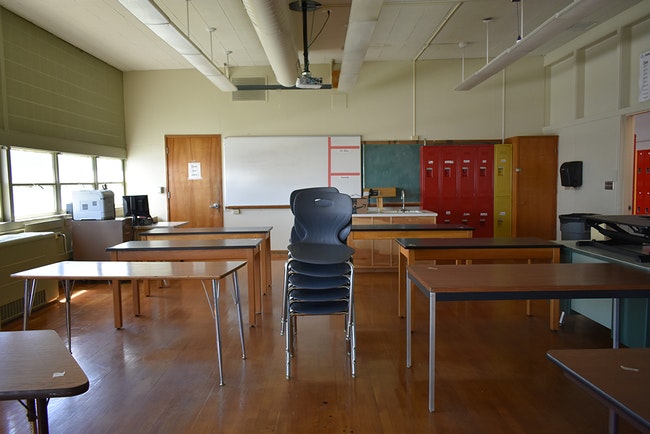
A classroom at Ontario High School. (The Enterprise/Rachel Parsons)
With one month left of summer, Malheur County schools are scrambling to figure out how to safely deliver an education to their students amid a pandemic.
Most of the plans are still in the works. Funding is not locked down. Guidelines change frequently.
Local districts are considering a hogs’ mosh of options.
Guidelines from the Oregon Department of Education require students to be placed in stable groups throughout the day, 35 square feet per student in each room for social distancing, and the education of students who are immunocompromised or have other diseases, even if they have to be taught at home while everyone else is in person.
Here is the latest from local districts on how they will return to school.
Vale School District
First day of school Aug. 17.
The Vale School District is aiming for a four-day-a-week in-person education for its approximately 900 students. The schools have enough space and faculty to teach classrooms even with the distance requirement, Superintendent Alisha McBride wrote to the Enterprise. Desks will be set six feet apart. Eighty-seven percent of parents, students and teachers responding to a district survey favored returning to the classroom.
The Vale district is not considering splitting students into morning or afternoon instruction, but will offer opportunities for online learning in addition to on-site.
Wi-Fi might not be required as part of the education plan, but the district has enough Chromebooks to loan out to students who need them.
Each staff member will be given a face shield, and the district will have masks available, although the district has not yet contracted for a supply.
Adrian School District
First day of school Aug. 24
Some Adrian High School classrooms don’t have the space to teach classes as done traditionally with the 35-square feet per student rule. Classrooms which could normally fit 22 can now only fit 12, said Kevin Purnell, Adrian School District superintendent.
The district is working to avoid splitting students into Monday-Tuesday and Thursday-Friday classes or morning and afternoon groups because of the impact that has on family schedules, and their desire to keep students in classrooms as much as possible.
The morning-afternoon split would increase transportation costs, and would mean some children couldn’t take care of or feed each other while their parents are normally out working. Teachers are most likely to move between classrooms instead of the students, and teachers might have to teach subjects they haven’t taught before.
Custodians might sanitize equipment before and after recess and lunch breaks, and the Adrian district will buy more hand sanitizer. They are still working on a cost estimate, Purnell said.
Students might have access to the playgrounds in staggered rotations, meaning multiple recess breaks throughout the day and different groups have access to different parts in a rotation, but that idea isn’t solid yet. Ontario is considering a similar plan.
Adrian teachers would most likely wear face shields, so students can see their mouth when speaking, and the district receives enough solicitations offering to sell personal protective equipment that Purnell doesn’t think supply will be an issue.
The Coalition of Oregon School Administrators and the Oregon Department of Education has training for teachers to teach safely in this altered format that teachers can take.
Adrian bought enough Chromebooks last year to provide one to everyone who requested one, but they are not a one Chromebook to one student district, Purnell said.
The district can’t use hotspots to provide Wi-Fi access to students in the country, but the district bought internet service for families that didn’t have it last year.
Ontario School District
First day of school Aug. 21.
The Ontario School District is considering rotating between virtual and classroom teaching for its 2,450 students. Sixty-five percent of survey respondents said they were comfortable returning to school.
Immuno-compromised students or students whose parents are worried for their safety can study through a distance learning plan, according to a written response from Taryn Smith, Ontario School District spokesperson. Meals will be delivered on campus or at bus stops, the cost of which the district hopes to offset with federal relief money.
The district has acquired 10,000 HN95 masks, and will be buying more protective equipment. Teachers are getting training on safety, sanitization, disease control, mental health screening and technology.
The district also bought an additional 750 Chromebooks, enough for every student and teacher, in case they need to deliver distance learning. Distance learning will have synchronous zoom sessions as a goal, but will likely use pre-recorded lectures.
Nyssa School District
First day of school Aug. 19.
The Nyssa School District will also try to get students on campus as much as possible.
“Kids need to be here. They need to be here to get the food, the structure, the loving adults, they get all the things and we’re going to find a way,” Superintendent Darren Johnson said.
Local superintendents aren’t the only ones advocating for in-person instruction.
U.S. Secretary of Education Betsy DeVos is pushing for in-person classes across the nation, the Associated Press reported, and the American Academy of Pediatrics released guidance urging a return to the classroom because of the social interaction and support schools provide.
Distance learning also brings equity issues for families without internet access or enough access to allow several children at once to attend school via the web.
Fifty-six percent of rural Malheur County residents have Wi-Fi with a download speed of 25 megabytes per second and upload of three megabytes per second, according to a 2019 federal report.
Zoom-based education plans also put the burden to teach more on family members than teachers, which is difficult for working parents or monolingual Spanish speakers when their child’s homework is in English, said Roberto Gamboa, operations manager for the Ontario-based Latino advocacy nonprofit Euvalcree.
Gamboa has joined state Sen. Lynn Fyndley, R-Vale, Lisa Longoria, Ontario Middle School principal, and 39 other Oregonians on the governor’s advisory Healthy Schools Reopening Council, which offers guidance on education department guidelines.
The main concern at the first council meeting was the what-if scenarios to keep students safe, Gamboa said. Covid cases are going to be found at the schools, so it’s best to have alternative education plans ready, planners concluded
Busing plans: double routes or business as usual
To get students to campus, local districts have to bus many of them. The new reopening guidelines from the Department of Education recommend three feet of social distancing on each bus.
The Adrian School District can’t promise that, said Purnell. The district has five buses which go on five routes, and doubling back on routes would be too expensive for the district. They probably will assign bus seats for students, but district officials aren’t considering screening students before they get on the bus.
The district already has some buses with seats that are significantly taller than the students, which establishes a natural barrier between students and which Department of Education guidance recommends.
The Nyssa School District normally transports 800 of its 1,300 students on 10 buses. They will ask parents to transport students as much as possible. A large bus normally fits over 100 students, but Johnson is planning on fitting 40 students on them now, and running them back and forth on two or three routes, screening student’s temperatures with distance thermometers before they step on board.
He’s looking for extra drivers to make it happen, and he’ll probably be driving a minibus himself, he said.
“At the end of the day, we’re going to do whatever it takes to keep our kids safe and we get them here,” Johnson said.
The Ontario district normally transports 1,500 of its 2,450 students with 17 routes, but they have a fleet of 29 buses of different sizes. The Vale district normally transports 446 of their 900 students on 13 buses with nine routes.
Oregon law requires school districts to provide busing for students who live outside of a mile radius of the school, so districts have the option of telling those students living closer to walk or bike to school.
Funding to stay even, governor promises
Reopening schools physically and safely during a pandemic comes at a price.
Between extra masks, bussing, and safety precautions, it adds up. The American Federation of Teachers predicted the yearly cost of safely reopening to be an additional $486 per student. For Nyssa, that would be an extra $578,000.
For a while, schools were worried that state school funding would be slashed along with the rest of the state budget as Oregon’s state tax income dropped by 20%. A rise in costs and a decrease in funding would have stopped any administrator’s heart.
On June 28, Gov. Kate Brown promised to protect state school funding from cuts, a blessing to administrators, but not a fully guaranteed promise. The governor is dependent on a special legislative session, where the funding for schools would be made complete by either a federal stimulus package, or tapping the state’s $2 billion in school reserves.
For Darren Johnson in Nyssa, the governor’s promise was exciting, reassuring and relieving.
The Vale School District is not counting on the governor’s promise. Their budget marks a $500,000 decrease from state funding, offset by $290,000 from the federal government. The district’s budget is expected to drop from $18 million to $16 million, although some of that decrease is from the 2016 school bond which ended last year.
To make up the difference, the Vale district is not rehiring for five positions: a special education teacher, a second-grade teacher, a librarian, a part-time dishwasher and a secretary.
The Vale district estimated providing food to children, and possibly delivering them during distance learning, would take $25,000 more than last year, and income from sales would decrease by just as much. The district appropriated $50,000 from the general fund to offset that cost.
The Adrian district increased its middle school employee travel budget by $450, to $3,000, and their alternative education travel budget from $750 to $1,500. The money would normally be used for employee travel to trainings and conferences, but now will likely be used for videoconferences, said Purnell. They also stopped hiring.
Since 2017, the district grew its reserves from $845,000 to $1.1 million, partly by cancelling gym renovations last year in anticipation of the budget crunch. They might draw on that money to fill in any budget gaps.
Purnell said the governor’s promise is nice, but he has worked in schools long enough to “know that cuts can come in the middle of the year.”
He described the whiplash administrators experienced from deciding where to spend an additional $328,500from the Student Success Act, to learn that their budgets could be cut by 10% and that the special funding would be reduced too.
“It was a real empty feeling. We thought we could do really great,” he said.
News tip? Contact reporter Aidan McGloin by email at [email protected] or call 541-473-3377.
KEEP THE ENTERPRISE GOING AS OTHERS CLOSE…..
Reader support allows the Enterprise to provide in-depth, accurate reporting that otherwise would not get done. Keeping the community well informed is essential. SUBSCRIBE – $5 a month, automatically. DONATE – to provide additional support.




